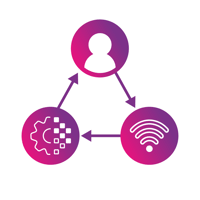Technology is transforming businesses, our lives and the way we work. With widespread access to new digital services helping businesses become more productive and increase engagement among employees, technology is a catalyst for innovation and is unlocking new opportunities for growth.
These opportunities are not lost on CIOs, who indicate a widespread belief that technology will transform their business more than any other global trend.
Many businesses are struggling to capitalise on their technology investments to improve business effectiveness. In many cases, that failure comes down to people. It’s estimated that nearly 70% of transformation projects fail due to employee resistance[1].
About the author
Louise Mahrra Head of Marketing for CAE.
 Having worked in a variety of industries through her career, from a world-leading technology brand, to Europe’s number 1 protein ingredients manufacturer, Louise is always focused on achieving high impact and value through thought leadership. Louise describes herself as first and foremost a storyteller who connects with her audience and creates meaningful content that excites, inspires and educates.
Having worked in a variety of industries through her career, from a world-leading technology brand, to Europe’s number 1 protein ingredients manufacturer, Louise is always focused on achieving high impact and value through thought leadership. Louise describes herself as first and foremost a storyteller who connects with her audience and creates meaningful content that excites, inspires and educates.
The new mindset: technology transformation is a people exercise
Too many businesses are stuck in the outdated view that digital transformation is primarily a technology deployment exercise. What they are missing is the recognition that most technology projects aiming to solve business problems, improve productivity or drive more value, require users to modify or completely alter their behaviour in order to be successful.
behaviour in order to be successful.
By ignoring this aspect or treating it as a training add-on at the end of the implementation, businesses are likely to fail on their original goals.
How can business leaders be expected to consistently unlock value from technology investments in a rapidly advancing world? The answer is both simple and infinitely complex: focus on the human experience – put users at the heart of change.
The message is coming across loud and clear: digital transformation is a people exercise.
10 steps to successful transformation
To realise true business value from technology transformation programmes, companies need to place people at the centre of the change.
1. Clearly identify the business outcome you are seeking to achieve
Start with WHY. It is important to understand what you are trying to achieve as a business. Technology should support the business and the users, so understanding what success looks like, and creating a business value case is fundamentally important as you start on your journey. If you don’t know where you are heading, you've got nothing to measure against.
Is the project all about cost savings? Are you trying to improve efficiencies and productivity in the workplace? Or is the driver behind this to improve customer experience?
Understand the ‘why’, set the milestones and focus on the end goal. Understanding what your business goal requirements are is key to a successful project.
2. Consider the people who will be impacted by the new technology
If your aim is to transform the way people work within your organisation, it will involve a major cultural3. Involve your people early on
Understand how your people work now, and most importantly, how they want to work. Get them involved in
![]() redefining their working processes. Set out clear goals and reasons for the transformation but invite them to experiment and contribute to an inclusive solution.
redefining their working processes. Set out clear goals and reasons for the transformation but invite them to experiment and contribute to an inclusive solution.
4. Anticipate the change curve
Your employees will have different reactions to change. Some will fear it and offer resistance, others will embrace and thrive on change. Identify and support natural innovators and encourage them to inspire those who lag behind.
5. Recognise the generational divide
Millennials (those born between 1980 and 1996) and Gen Z (the generation that was born between 1996-2010) have grown up with ever-changing technology and are used to communicating via multiple tools and media (including video). For them, doing things on the move, hot desking and agile working is likely to be seen as a more attractive option than a traditional set up.
Employees in their 40s and above may be less enthusiastic about new technology. They may need additional training to ensure they feel comfortable and fluent with new platforms. Older habits can be harder to break and the propensity to change does vary across generations. Support training and adoption through mentorships and partnerships. Match boomers with millennials to speed up the learning process and break down inter-generational barriers. Build a culture of encouragement and inclusion.
6. Streamline, automate, and transform processes
![]() Make sure other organisational aspects are aligned to drive the right behaviour. This includes refining or modifying business processes and looking at any necessary governance to support change, including policies around areas such as travel, for example. Improving the way people work through streamlining, automating, and transforming processes with rich forms, workflows, and custom apps empowers an inclusive modern workplace culture that benefits users and the business.
Make sure other organisational aspects are aligned to drive the right behaviour. This includes refining or modifying business processes and looking at any necessary governance to support change, including policies around areas such as travel, for example. Improving the way people work through streamlining, automating, and transforming processes with rich forms, workflows, and custom apps empowers an inclusive modern workplace culture that benefits users and the business.
7. Introduce technology in phases with maximum support and clear feedback processes
Business change projects should be managed with care, as it can be hard on your users and increases the risks of poor user adoption. In many cases, it is wise to transition to new technologies or ways of working using a phased approach, which will help to manage the change over time.
8. Invest in change
So many times, technology change projects fail due to investment in devices, such as headsets. Often, budgets are not fully forecast so when it comes to the right device for users, these are often an afterthought. Don’t short cut on devices or you won’t get the utilisation you want; user uptake will be low and you run the risk of introducing a shadow IT and bring your own device culture.
9. Don’t relax too soon
Even if you engage people around the launch of a new technology, if the user experience is poor and it isn’t accompanied by a change in culture, there is a strong possibility the business outcome won’t be realised.
10. Map and monitor usage
Identify what is being used, where and when. Build on engagement and look for continuous improvement areas. It’s an ongoing process.
Our Approach

For 30 years, CAE has been working with organisations to successfully implement transformative digital technologies which deliver defined business outcomes.
We understand how our customers use technology, and how it can transform what they do. Our role is to enable the successful adoption of that technology. We’ll work with you to plan and implement your technology transformation journey – then be alongside you every step of the way.
By engaging users early, understanding their roles and pinpointing their needs, CAE can demonstrate value to them and you, and help develop a culture of acceptance before a single piece of technology is deployed.
At CAE, we’ve developed an approach to make technology transformation simpler, faster, smoother and less daunting..
[1] McKinsey

